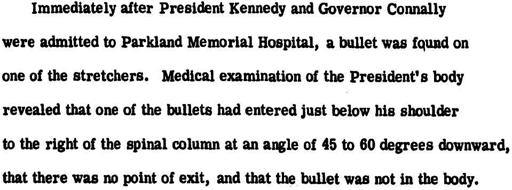Impossible: The Case Against Lee Harvey Oswald (33 page)
Read Impossible: The Case Against Lee Harvey Oswald Online
Authors: Barry Krusch
Tags: #Non-Fiction, #History

BOOK: Impossible: The Case Against Lee Harvey Oswald
12Mb size Format: txt, pdf, ePub
Chapter 9
Proposition One, Element One: Exactly 3 Shots Fired
Initial Discussion
Let’s analyze our first element:
Exactly three shots were fired from the sixth-floor southeast window of the Texas School Book Depository at Dealey Plaza on November 22, 1963 — no more, no less — and the three shells found on the floor of the Depository — in the possession of the Warren Commission — were fired from Lee Harvey Oswald’s rifle, to the exclusion of all other weapons in the world.
This element is a composite derived from three conclusions of the
Warren Report
, and a statement by FBI Firearms Identification Expert Robert Frazier in hearings before the Commission, first the conclusion 2 on p. 19 that three shots were fired,
Next, conclusion 4 on p. 19 that Oswald fired the shots,
Next, a statement by FBI agent Robert Frazier in hearings before the Warren Commission that the three shells in the possession of the Commission were fired from Oswald’s rifle and only Oswald’s rifle (3 H 416):
And finally, the conclusion 11 on p. 22 that
only
Oswald fired the shots:
The relationship of this last conclusion to the others is clear: if Oswald acted alone, then obviously no other shots were fired other than the three he was alleged to have fired.
These conclusions above were based on evidence reported by the Warren Commission. In subsequent sections of their report, they provided the following types of evidence:
- Photographs
of spent hulls and a live round (as above). - Officer testimony
regarding the number of empty shells found (three). - Earwitness testimony
regarding the number of shots fired (the majority of the witnesses interviewed by the Warren Commission reported hearing three shots). - Forensic evidence
related to the wounds of JFK/Connally, as well as certain ballistic evidence and evidence of bullet strikes.
Naturally, we are going to take a much closer look at this evidence in this chapter, but for now let us assume that this is
all
the evidence (and therefore we met our requirement that the evidence be
comprehensive
), and that the Warren Commission is 100%
credible
. Let us also assume that we are confident that this evidence is
sufficient
, and since it all tells the same story, it obviously is
consistent
. Therefore, our four parameters based on these assumptions would be met.
If that is the case, what would our confidence level be regarding this element? Very high, as follows:
Take a good look at those numbers, the last time you’re going to see numbers that high . . . from now on, they are headed inexorably South.
As you might have guessed by virtue of the fact that you have this book in your hand, at least one of the assumptions above is incorrect: we have not seen
all
the evidence, not by a long shot. There are numerous pieces of the puzzle which the Warren Commission did not bother to share with their American audience when they first published the Report. As the months and years passed, and as more and more information was revealed, ultimately this extremely high confidence level began to sink into the quicksand created by these new revelations. When we analyze the evidence originally hidden from our view, we see that there is definitely another (seamy) side to the story.
Consider the following screen captures from Commission Documents utilized by the Warren Commission but not released in the 27 Hearing and Exhibit Volumes. The following capture is from Page 1 of Commission Document 1, a Summary Report by the FBI provided to the Warren Commission of the evidence gathered, dated December 9, 1963, but only revealed to the public in May of 1966 (
Accessories After the Fact
, p. 148), over a year and a half after the publication of the Report on September 24, 1964:
1
At first glance, this paragraph seems to indicate that of the three shots fired, 2 separate shots hit President Kennedy, and another shot wounded Governor Connally: three shots, three separate hits. However, there is an ambiguity in the sentence “Two bullets struck President Kennedy, and one wounded Governor Connally.” One possible interpretation of this sentence — in a departure from the plain meaning of the text — is that one of the bullets referenced as having struck President Kennedy could have passed through the President’s body to strike Governor Connally. Under that interpretation, there would still be three separate hits, but by two shots, not three.
However, a complete refutation of this alternative interpretation was provided just seventeen pages later. According to Page 18 of Commission Document 1, the bullet that struck President Kennedy in the back — the only of the two bullets that could have passed through the body of President Kennedy to strike Governor Connally — did in fact
not
transit the President’s body:
2
This statement, written before the autopsy report was delivered on December 23 (RH 457), was confirmed less than five weeks later in a Supplement to the December 9, 1963 FBI report. Because it was dated January 13, 1964, the Supplement post-dated the receipt of the autopsy report, and included the information contained within that autopsy report, confirming what had previously been “unofficial” reports:
3
Other books
Winter's Tide by Lisa Williams Kline
Mr. Darcy's Christmas Carol by Carolyn Eberhart
Mean Spirit by Will Kingdom
Cat Fear No Evil by Shirley Rousseau Murphy
First Chances by Kant, Komal
When Demons Walk by Patricia Briggs
The Heir Agreement by Leon, Kenzie
A Rebel Captive by Thompson, J.D.
The Needle's Eye by Margaret Drabble
Vengeance by Karen Lewis








